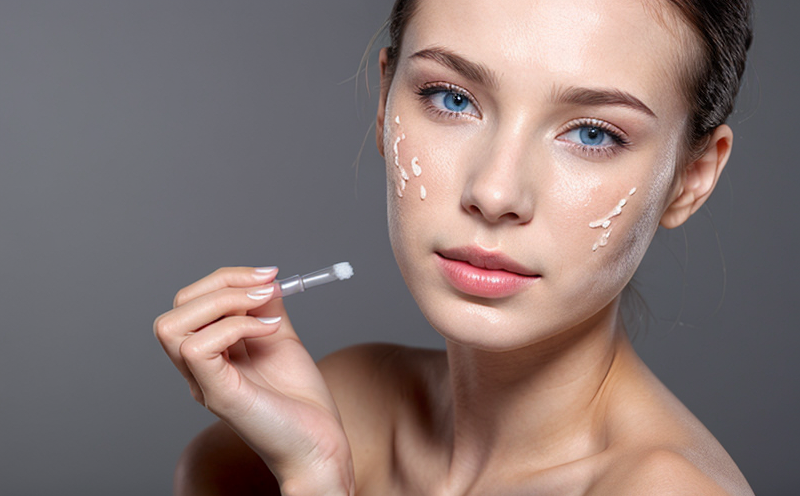OECD TG 431 In Vitro Skin Corrosion Testing
The OECD Test Guideline 431 provides a robust framework for assessing the skin corrosivity of cosmetic products. This in vitro test method aims to predict whether a chemical or cosmetic formulation will cause irreversible damage to the skin, thereby identifying potential irritants and sensitizers.
The test involves exposing human skin substitutes (HSS) to the test substance under controlled conditions over a period of 4 hours. The HSS used are highly sophisticated models that mimic human skin physiology, making this test both efficient and reliable. The methodology is designed to comply with OECD standards, ensuring consistency and comparability across different laboratories.
The primary outcome measure in OECD TG 431 is the percentage of damaged cells within the stratum corneum layer after exposure. This layer is crucial as it forms the outermost part of human skin, acting as a barrier against external substances. By quantifying cell damage, we can determine the corrosive potential of the substance.
For quality managers and compliance officers, this test offers valuable insights into the safety profile of cosmetic products before they reach the market. It is especially useful for R&D engineers in refining formulations to avoid skin irritants. Additionally, procurement teams benefit by ensuring that only safe ingredients are incorporated into product development pipelines.
The OECD TG 431 method has been validated against other traditional in vivo methods and shows high correlation with clinical outcomes. This makes it a preferred choice for regulatory submissions and internal quality assurance processes.
In summary, the OECD TG 431 In Vitro Skin Corrosion Test is an essential tool in cosmetic product safety assessment. It provides reliable data without the ethical concerns associated with animal testing, making it a cornerstone of modern cosmetics development.
Scope and Methodology
| Stage | Description | Objective |
|---|---|---|
| Preparation | The HSS is prepared according to standard protocols. This involves hydrating the model skin and ensuring it is stable for testing. | To ensure that the test substrate is in optimal condition prior to exposure. |
| Exposure | The test substance is applied to the HSS, allowing it to remain on the surface for 4 hours under controlled conditions. | To evaluate the corrosive potential of the product by measuring cell damage over time. |
| Post-Exposure | An appropriate fixative is used to preserve the post-exposure HSS. This step ensures that the sample remains intact for accurate analysis. | To maintain the integrity of the sample for subsequent evaluation and measurement. |
| Evaluation | The extent of cellular damage in the stratum corneum layer is quantified using advanced imaging techniques or biochemical assays. This provides a precise measure of skin corrosivity. | To determine if there has been irreversible cell damage, which would indicate potential skin irritation or sensitization. |
| Reporting | The results are compiled into a comprehensive report that includes the percentage of damaged cells and any other relevant data. This report is submitted to regulatory bodies for approval. | To provide transparent and accurate documentation of the test outcomes, ensuring compliance with international standards. |
Eurolab Advantages
At Eurolab, we pride ourselves on delivering high-quality, reliable, and compliant testing services. Our team of experts ensures that every step of the OECD TG 431 test is meticulously followed, from sample preparation to final analysis.
We use state-of-the-art equipment and adhere strictly to international standards such as ISO 10993-10:2012 for in vitro testing. Our facilities are equipped with advanced imaging systems capable of detecting even the slightest changes in cellular integrity. This precision allows us to provide accurate results that meet rigorous regulatory requirements.
Our experienced professionals understand the nuances of cosmetic product development and can offer valuable insights into formulation adjustments based on our test outcomes. Whether you need compliance testing or R&D support, Eurolab is your partner in ensuring safety and efficacy.
In addition to technical excellence, we prioritize customer satisfaction. Our transparent communication ensures that clients are well-informed throughout the testing process. We also offer flexible scheduling options to accommodate busy schedules and tight deadlines.
Why Choose This Test
The OECD TG 431 In Vitro Skin Corrosion Test is an indispensable tool in cosmetic product safety assessment due to its reliability, efficiency, and alignment with international standards. Here are several reasons why you should choose this test:
Rigorous Compliance: The test ensures strict adherence to OECD guidelines, providing data that is widely accepted by regulatory authorities.
Ethical Considerations: By opting for in vitro testing over traditional animal models, you contribute to a more humane approach to product safety assessment.
Time and Cost Efficiency: The 4-hour exposure period significantly reduces the time required compared to in vivo methods. Additionally, the cost per test is lower due to reduced resource consumption.
Data Accuracy: Our advanced imaging techniques provide highly accurate measurements of cellular damage, ensuring reliable results.
Regulatory Acceptance: The OECD TG 431 has been validated against other in vivo methods and shows high correlation with clinical outcomes, making it a preferred choice for regulatory submissions.
Comprehensive Support: Our team offers comprehensive support from formulation development to final analysis, ensuring that your product meets the highest safety standards.





